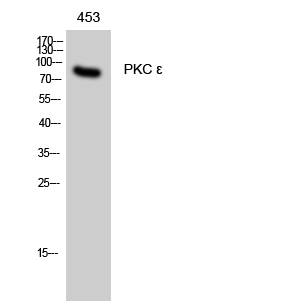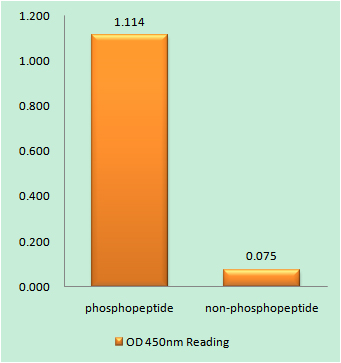
Catalog: YP0340
Size
Price
Status
Qty.
200μL
$600.00
In stock
0
100μL
$340.00
In stock
0
50μL
$190.00
In stock
0
Add to cart


Collected


Collect
Main Information
Target
PKC ε
Host Species
Rabbit
Reactivity
Human, Mouse, Rat
Applications
WB, ELISA, IHC
MW
83kD (Observed)
Conjugate/Modification
Phospho
Detailed Information
Recommended Dilution Ratio
WB 1:500-2000; IHC 1:50-300; ELISA 1:2000-20000
Formulation
Liquid in PBS containing 50% glycerol, 0.5% BSA and 0.02% sodium azide.
Specificity
Phospho-PKC ε (S729) Polyclonal Antibody detects endogenous levels of PKC ε protein only when phosphorylated at S729.The name of modified sites may be influenced by many factors, such as species (the modified site was not originally found in human samples) and the change of protein sequence (the previous protein sequence is incomplete, and the protein sequence may be prolonged with the development of protein sequencing technology). When naming, we will use the "numbers" in historical reference to keep the sites consistent with the reports. The antibody binds to the following modification sequence (lowercase letters are modification sites):GFsYF
Purification
The antibody was affinity-purified from rabbit antiserum by affinity-chromatography using epitope-specific immunogen.
Storage
-15°C to -25°C/1 year(Do not lower than -25°C)
Concentration
1 mg/ml
MW(Observed)
83kD
Modification
Phospho
Clonality
Polyclonal
Isotype
IgG
Related Products
Antigen&Target Information
Immunogen:
The antiserum was produced against synthesized peptide derived from human PKC epsilon around the phosphorylation site of Ser729. AA range:688-737
show all
Specificity:
Phospho-PKC ε (S729) Polyclonal Antibody detects endogenous levels of PKC ε protein only when phosphorylated at S729.The name of modified sites may be influenced by many factors, such as species (the modified site was not originally found in human samples) and the change of protein sequence (the previous protein sequence is incomplete, and the protein sequence may be prolonged with the development of protein sequencing technology). When naming, we will use the "numbers" in historical reference to keep the sites consistent with the reports. The antibody binds to the following modification sequence (lowercase letters are modification sites):GFsYF
show all
Gene Name:
PRKCE
show all
Protein Name:
Protein kinase C epsilon type
show all
Other Name:
PRKCE ;
PKCE ;
Protein kinase C epsilon type ;
nPKC-epsilon
PKCE ;
Protein kinase C epsilon type ;
nPKC-epsilon
show all
Database Link:
Background:
protein kinase C epsilon(PRKCE) Homo sapiens Protein kinase C (PKC) is a family of serine- and threonine-specific protein kinases that can be activated by calcium and the second messenger diacylglycerol. PKC family members phosphorylate a wide variety of protein targets and are known to be involved in diverse cellular signaling pathways. PKC family members also serve as major receptors for phorbol esters, a class of tumor promoters. Each member of the PKC family has a specific expression profile and is believed to play a distinct role in cells. The protein encoded by this gene is one of the PKC family members. This kinase has been shown to be involved in many different cellular functions, such as neuron channel activation, apoptosis, cardioprotection from ischemia, heat shock response, as well as insulin exocytosis. Knockout studies in mice suggest that this kinase is important for lipopolysaccharide (LPS)-mediated signaling in activated macro
show all
Function:
Catalytic activity:ATP + a protein = ADP + a phosphoprotein.,Domain:The C1 domain, containing the phorbol ester/DAG-type region 1 (C1A) and 2 (C1B), is the diacylglycerol sensor and the C2 domain is a non-calcium binding domain.,enzyme regulation:Three specific sites; Thr-566 (activation loop of the kinase domain), Thr-710 (turn motif) and Ser-729 (hydrophobic region), need to be phosphorylated for its full activation.,Function:PKC is activated by diacylglycerol which in turn phosphorylates a range of cellular proteins. PKC also serves as the receptor for phorbol esters, a class of tumor promoters.,Function:This is calcium-independent, phospholipid-dependent, serine- and threonine-specific enzyme.,PTM:Phosphorylation on Thr-566 by PDPK1 triggers autophosphorylation on Ser-729.,similarity:Belongs to the protein kinase superfamily. AGC Ser/Thr protein kinase family. PKC subfamily.,similarity:Contains 1 AGC-kinase C-terminal domain.,similarity:Contains 1 C2 domain.,similarity:Contains 1 protein kinase domain.,similarity:Contains 2 phorbol-ester/DAG-type zinc fingers.,subunit:Forms a ternary complex with TRIM63 and GN2BL1.,
show all
Cellular Localization:
Cytoplasm . Cytoplasm, cytoskeleton . Cell membrane . Cytoplasm, perinuclear region . Nucleus . Translocated to plasma membrane in epithelial cells stimulated by HGF (PubMed:17603037). Associated with the Golgi at the perinuclear site in pre-passage fibroblasts (By similarity). In passaging cells, translocated to the cell periphery (By similarity). Translocated to the nucleus in PMA-treated cells (By similarity). .
show all
Tissue Expression:
Expressed in cumulus cells (at protein level).
show all
Research Areas:
>>cGMP-PKG signaling pathway ;
>>Sphingolipid signaling pathway ;
>>Vascular smooth muscle contraction ;
>>Apelin signaling pathway ;
>>Tight junction ;
>>Fc gamma R-mediated phagocytosis ;
>>Inflammatory mediator regulation of TRP channels ;
>>Aldosterone synthesis and secretion ;
>>Type II diabetes mellitus ;
>>Insulin resistance ;
>>AGE-RAGE signaling pathway in diabetic complications ;
>>Shigellosis ;
>>MicroRNAs in cancer
>>Sphingolipid signaling pathway ;
>>Vascular smooth muscle contraction ;
>>Apelin signaling pathway ;
>>Tight junction ;
>>Fc gamma R-mediated phagocytosis ;
>>Inflammatory mediator regulation of TRP channels ;
>>Aldosterone synthesis and secretion ;
>>Type II diabetes mellitus ;
>>Insulin resistance ;
>>AGE-RAGE signaling pathway in diabetic complications ;
>>Shigellosis ;
>>MicroRNAs in cancer
show all
Signaling Pathway
Cellular Processes >> Cellular community - eukaryotes >> Tight junction
Organismal Systems >> Immune system >> Fc gamma R-mediated phagocytosis
Organismal Systems >> Endocrine system >> Aldosterone synthesis and secretion
Organismal Systems >> Circulatory system >> Vascular smooth muscle contraction
Organismal Systems >> Sensory system >> Inflammatory mediator regulation of TRP channels
Human Diseases >> Cancer: overview >> MicroRNAs in cancer
Environmental Information Processing >> Signal transduction >> Apelin signaling pathway
Environmental Information Processing >> Signal transduction >> Sphingolipid signaling pathway
Environmental Information Processing >> Signal transduction >> cGMP-PKG signaling pathway
Reference Citation({{totalcount}})
Catalog: YP0340
Size
Price
Status
Qty.
200μL
$600.00
In stock
0
100μL
$340.00
In stock
0
50μL
$190.00
In stock
0
Add to cart


Collected


Collect
Recently Viewed Products
Clear allPRODUCTS
CUSTOMIZED
ABOUT US
Toggle night Mode
{{pinfoXq.title || ''}}
Catalog: {{pinfoXq.catalog || ''}}
Filter:
All
{{item.name}}
{{pinfo.title}}
-{{pinfo.catalog}}
Main Information
Target
{{pinfo.target}}
Reactivity
{{pinfo.react}}
Applications
{{pinfo.applicat}}
Conjugate/Modification
{{pinfo.coupling}}/{{pinfo.modific}}
MW (kDa)
{{pinfo.mwcalc}}
Host Species
{{pinfo.hostspec}}
Isotype
{{pinfo.isotype}}
Product {{index}}/{{pcount}}
Prev
Next
{{pvTitle}}
Scroll wheel zooms the picture
{{pvDescr}}




















